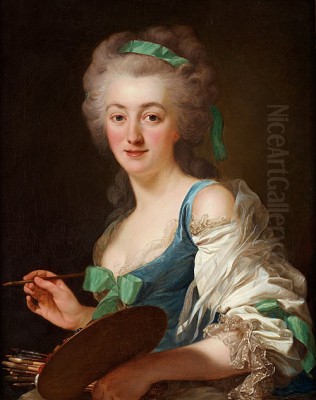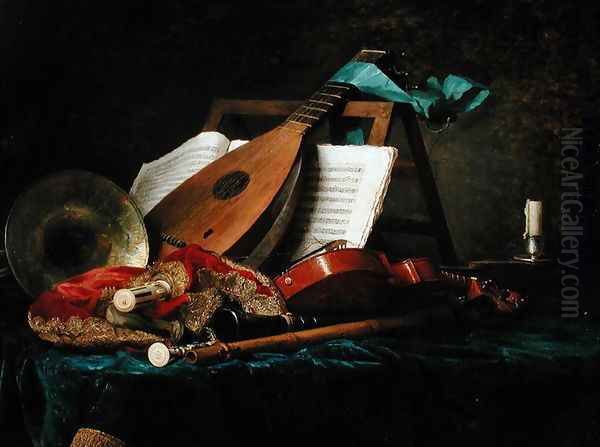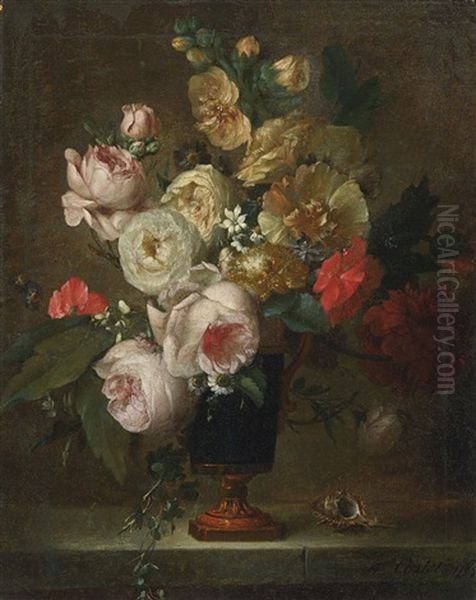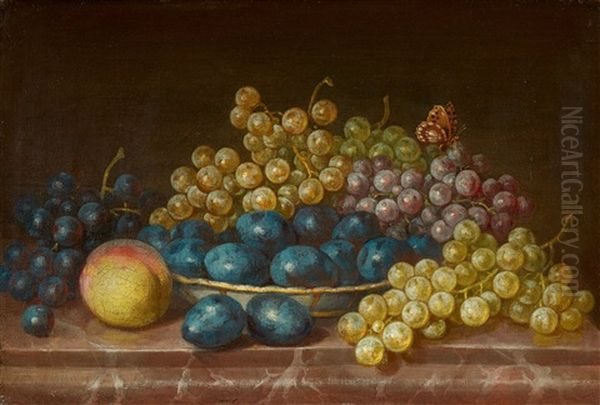
Anne Vallayer-Coster (1744-1818) stands as one of the most accomplished and respected female artists of 18th-century France. In an era when opportunities for women in the arts were severely limited, she not only gained admission to the prestigious Royal Academy of Painting and Sculpture but also enjoyed significant royal patronage, particularly from Queen Marie Antoinette. Her oeuvre, primarily consisting of exquisitely detailed still lifes, but also encompassing portraits and genre scenes, showcases a remarkable technical skill and a refined aesthetic sensibility that bridged the Rococo and emerging Neoclassical styles.
Early Life and Artistic Inclinations
Born in Paris on December 21, 1744, Anne Vallayer came from a family with artistic connections, which likely provided her initial exposure and encouragement. Her father, Joseph Vallayer, was a goldsmith working for the royal Gobelins tapestry manufactory, a position that would have immersed the family in an environment of craftsmanship and design. Her mother, Anne Cornut, was reportedly a painter of miniatures, though little is known about her work. This familial background in the applied and fine arts undoubtedly played a role in nurturing young Anne's talents.
Unlike many male artists of the period who benefited from formal apprenticeships and the rigorous training of the Academy schools from a young age, Vallayer's early artistic education was likely more informal. It is believed she received guidance from Madeleine Françoise Basseporte, a noted botanical illustrator and the official designer for the Royal Garden (Jardin du Roi). This connection would have honed her skills in precise observation and detailed rendering of natural forms, particularly flowers, which became a recurring motif in her work.
There is also speculation that she may have received some instruction from the celebrated marine painter Joseph Vernet, known for his dramatic seascapes and atmospheric effects. While direct evidence is scarce, Vernet was a family friend, and his influence, particularly in terms of composition and the handling of light, can be subtly discerned in some of her more complex arrangements. The artistic environment of Paris, bustling with studios and Salons, would have provided further informal learning opportunities.
Admission to the Royal Academy: A Testament to Talent

The Royal Academy of Painting and Sculpture (Académie Royale de Peinture et de Sculpture) was the paramount artistic institution in France, and membership was crucial for professional recognition and access to royal commissions. For women, entry was exceptionally difficult, with strict quotas and societal biases often barring their way. Despite these hurdles, Anne Vallayer sought admission, a bold move for a young woman.
In 1770, at the age of twenty-six, Anne Vallayer was unanimously accepted into the Academy as a painter of still life. This was a remarkable achievement. She submitted two ambitious still life paintings as her reception pieces: The Attributes of Painting, Sculpture, and Architecture and The Attributes of Music (both 1769, now in the Louvre Museum, Paris). These works demonstrated not only her technical prowess in rendering diverse textures—gleaming metal, rich fabrics, polished wood, delicate paper—but also her intellectual capacity to engage with allegorical themes traditionally associated with "higher" genres of art.
Her acceptance was championed by influential figures within the Academy, and contemporary critics, including the encyclopedist Denis Diderot, praised her skill. Diderot, known for his often sharp critiques of Salon exhibitions, was notably impressed by her work, commenting on its truthfulness and the beauty of her execution. This early recognition set the stage for a long and productive career.
The Zenith of Still Life: Vallayer-Coster's Signature Genre
Still life, though considered lower in the academic hierarchy of genres than history painting or portraiture, offered a space where female artists could excel without transgressing societal expectations regarding subject matter. Anne Vallayer-Coster elevated the genre with her sophisticated compositions, rich color palettes, and meticulous attention to detail. Her still lifes are far from mere decorative pieces; they are carefully constructed studies of form, texture, light, and color.
Her subjects ranged from opulent floral arrangements and bountiful displays of fruit to arrangements of game, fish, and everyday household objects. Works like Still Life with Lobster (1817, Louvre Museum) showcase her ability to capture the iridescent sheen of the lobster's shell, the glistening moisture on accompanying vegetables, and the varied textures of ceramics and linens. The composition is dynamic yet balanced, drawing the viewer's eye across the canvas.

Another masterpiece, Still Life with Mackerel, Glassware, a Loaf of Bread, and Lemons on a Table with a White Tablecloth (c. 1774, Kimbell Art Museum), demonstrates her skill in rendering reflective surfaces and the subtle interplay of light and shadow. The silvery scales of the mackerel, the transparency of the glass, and the crumbly texture of the bread are all rendered with astonishing verisimilitude. She often employed a dark, neutral background, which made her subjects stand out with luminous clarity, a technique reminiscent of earlier Dutch masters but infused with French elegance.
While often compared to her great contemporary Jean-Baptiste-Siméon Chardin, the undisputed master of still life in 18th-century France, Vallayer-Coster's approach differed. Chardin's works often evoke a sense of quiet, bourgeois domesticity and a profound, almost spiritual, contemplation of humble objects. Vallayer-Coster, while equally skilled in capturing realism, often imbued her still lifes with a greater sense of abundance, decorative richness, and an aristocratic flair, perhaps reflecting the tastes of her patrons. Her floral still lifes, in particular, are vibrant and lush, showcasing a wide variety of species rendered with botanical accuracy yet arranged with artistic grace.
Ventures into Portraiture and Genre Scenes
Although primarily celebrated for her still lifes, Anne Vallayer-Coster also produced a number of accomplished portraits and a few genre scenes. Her foray into portraiture was perhaps an attempt to engage with a more prestigious and potentially more lucrative genre. While she may not have achieved the same level of fame in this field as contemporaries like Élisabeth Vigée Le Brun or Adélaïde Labille-Guiard, her portraits are characterized by a sensitive portrayal of her sitters and a continued attention to the rendering of fabrics and accessories.
One of her notable portraits is the Portrait of a Violinist (1773, Nationalmuseum, Stockholm), believed to depict one of her sisters. The work is intimate and captures a moment of quiet concentration. The textures of the musician's silk dress and the polished wood of the violin are rendered with her characteristic skill. She also painted portraits of members of the aristocracy and her own family.
Her genre scenes are less common but demonstrate her versatility. These works often depict domestic activities or allegorical figures, treated with the same careful execution as her still lifes. However, it was in the realm of still life that her genius truly shone, and it remained her primary focus throughout her career. The demands of portraiture, often requiring extensive sittings and a different kind of interaction with patrons, may have been less suited to her temperament, which was often described as modest and diligent.
Royal Patronage: The Favor of Marie Antoinette

In 1781, Anne Vallayer married Jean-Pierre Silvestre Coster, a wealthy lawyer and member of a respected family from Lorraine. This marriage provided her with financial security and elevated her social standing. She began signing her works "Vallayer-Coster." Around this time, she also secured the patronage of Queen Marie Antoinette.
Marie Antoinette was a significant patron of the arts and particularly supportive of female artists. Vallayer-Coster was granted studio space in the Louvre, a privilege reserved for esteemed artists, and received numerous commissions from the Queen and other members of the royal court and aristocracy. This patronage was crucial for her career, providing not only financial support but also enhancing her prestige. She painted floral arrangements for the Queen's private apartments and portraits of members of her circle.
Her connection to Marie Antoinette, while beneficial during the Ancien Régime, would become a potential liability during the French Revolution. However, her reputation as a skilled and dedicated artist, coupled with a generally apolitical stance in her work, helped her navigate the turbulent years that followed. The Queen's aunts, Mesdames Adélaïde and Victoire, were also among her important patrons.
Navigating the French Revolution and Later Career
The French Revolution, which began in 1789, brought profound changes to French society and the art world. The abolition of the Royal Academy in 1793 and the fall of the monarchy disrupted traditional systems of patronage. Many artists with royal connections faced scrutiny or hardship. While Vallayer-Coster's association with Marie Antoinette could have been problematic, she managed to continue her career, albeit with a shift in clientele.
She continued to exhibit at the Salon, which became more open to a wider range of artists after the Revolution. Her still lifes, with their focus on the beauty of the natural world and everyday objects, were perhaps less politically charged than other genres and continued to find an audience. She adapted to the changing times, seeking patronage from the new elite that emerged during the Napoleonic era.
Despite the upheavals, her dedication to her art remained unwavering. She continued to produce works of high quality well into the early 19th century. Her later works, such as the aforementioned Still Life with Lobster (1817), show no decline in her technical skill or artistic vision. She remained active until her death in Paris on February 28, 1818, at the age of 73.
Artistic Style and Technical Mastery
Anne Vallayer-Coster's artistic style is characterized by a blend of Rococo elegance and a burgeoning Neoclassical clarity. Her compositions are typically well-balanced and harmonious, often employing a pyramidal or diagonal structure to create visual interest. She had an exceptional eye for detail, meticulously rendering the varied textures of flowers, fruits, fabrics, metals, and ceramics.
Her use of color was sophisticated, ranging from vibrant and rich hues in her floral pieces to more subdued and subtle palettes in her depictions of game or kitchen scenes. She was a master of chiaroscuro, using light and shadow to model forms and create a sense of depth and volume. Her brushwork, while precise, could also be fluid and expressive, particularly in the rendering of delicate flower petals or the sheen of silk.
Compared to the more flamboyant Rococo style of artists like Jean-Honoré Fragonard or François Boucher, Vallayer-Coster's work exhibits a greater sense of order and naturalism, aligning her more closely with the tradition of Chardin. However, her art often possesses a decorative quality and a refinement that speaks to the aristocratic tastes of her patrons, distinguishing her from Chardin's more rustic simplicity. She was less interested in the overt moralizing or grand narratives seen in the work of history painters like Jacques-Louis David, who came to dominate the art scene during the Neoclassical period. Instead, she found profound beauty and artistic challenge in the careful observation and representation of the world around her.
Contemporaries and the Artistic Milieu of 18th-Century Paris
Anne Vallayer-Coster worked during a vibrant period in French art history, surrounded by a constellation of talented artists. Her primary point of comparison in still life is, of course, Jean-Baptiste-Siméon Chardin (1699-1779), whose work set a high standard for the genre. Another notable still life and animal painter was Jean-Baptiste Oudry (1686-1755), known for his hunting scenes and detailed depictions of animals, whose influence might be seen in her game pieces.
In the realm of portraiture, she was a contemporary of two other highly successful female artists: Élisabeth Vigée Le Brun (1755-1842) and Adélaïde Labille-Guiard (1749-1803). Both Vigée Le Brun and Labille-Guiard were also members of the Royal Academy and enjoyed royal patronage, particularly from Marie Antoinette in Vigée Le Brun's case. Their careers, focused primarily on portraiture, often overshadowed Vallayer-Coster's achievements in that genre, but all three women navigated the male-dominated art world with remarkable success.
The broader artistic landscape included dominant figures of the Rococo like François Boucher (1703-1770) and Jean-Honoré Fragonard (1732-1806), whose styles emphasized grace, sensuality, and decorative charm. As Vallayer-Coster's career progressed, the Neoclassical movement gained ascendancy, championed by Jacques-Louis David (1748-1825). While her work did not fully embrace Neoclassicism, its emphasis on clarity, order, and naturalism resonated with some aspects of the emerging style.
Other important figures included portraitists like Jean-Marc Nattier (1685-1766), known for his idealized portraits of court ladies, and genre painters like Jean-Baptiste Greuze (1725-1805), whose sentimental and moralizing scenes were highly popular. Her teacher, Madeleine Françoise Basseporte (1701-1780), was a key figure in botanical illustration, and her possible mentor, Joseph Vernet (1714-1789), was renowned for his seascapes. Internationally, female artists like Rosalba Carriera (1673-1757) from Italy (a generation earlier but influential) and Angelica Kauffman (1741-1807), a Swiss-Austrian Neoclassical painter active in London and Rome, were also making significant contributions, demonstrating that women could achieve artistic prominence.
Anecdotes and Character: A Modest Professional
Historical records and contemporary accounts portray Anne Vallayer-Coster as a modest, diligent, and highly professional artist. Unlike some of her more flamboyant contemporaries, she seems to have avoided courtly intrigue and focused intently on her work. Denis Diderot, in his Salon reviews, not only praised her talent but also commented on her unassuming demeanor.
One anecdote suggests that upon her admission to the Academy, some male academicians were initially skeptical, perhaps due to her gender or the perceived lesser status of still life painting. However, the quality of her reception pieces quickly silenced any doubts and earned her their respect. Her ability to secure and maintain royal patronage, particularly from a discerning figure like Marie Antoinette, speaks to both her artistic skill and her professional conduct.
Her marriage to Jean-Pierre Silvestre Coster appears to have been a supportive one, allowing her to continue her artistic pursuits without the financial pressures faced by some artists. She maintained a studio in the Louvre for many years, a testament to her recognized status. Despite the turmoil of the Revolution, she continued to work and exhibit, demonstrating resilience and a deep-seated passion for her art. Her life, though less documented than some of her peers, reveals a woman of talent, determination, and quiet strength.
Legacy and Rediscovery: An Enduring Brilliance
For a period after her death, Anne Vallayer-Coster's work, like that of many female artists of the past, was somewhat overlooked by art history, which tended to focus on male artists and "higher" genres. However, in the late 19th and 20th centuries, a renewed interest in still life painting and a growing recognition of the contributions of women artists led to her rediscovery.
Today, Anne Vallayer-Coster is recognized as one of the foremost still life painters of the 18th century and a significant figure in the history of women artists. Her works are held in major museums around the world, including the Louvre Museum in Paris, the Metropolitan Museum of Art in New York, the National Gallery of Art in Washington D.C., and the Kimbell Art Museum in Fort Worth.
Her legacy lies in the sheer beauty and technical brilliance of her paintings. She demonstrated that still life could be a vehicle for profound artistic expression, capable of conveying elegance, abundance, and a deep appreciation for the material world. Her success in gaining admission to the Royal Academy and securing royal patronage paved the way for future generations of women artists. Her ability to capture the diverse textures and forms of nature and human craftsmanship with such precision and artistry continues to captivate viewers and inspire artists today.
Her influence can be seen in the continued tradition of still life painting, and her work serves as an important reminder of the rich artistic contributions made by women, often against considerable odds. The meticulous detail, harmonious compositions, and luminous quality of her paintings ensure her enduring place in the canon of Western art.
Conclusion: A Lasting Impression
Anne Vallayer-Coster was an artist of exceptional talent and dedication who carved out a successful career in the competitive art world of 18th-century Paris. Her mastery of still life, characterized by exquisite detail, rich color, and sophisticated composition, earned her critical acclaim, academic recognition, and the patronage of Queen Marie Antoinette. While also producing accomplished portraits, it is her still lifes that form the core of her artistic achievement.
Navigating the societal constraints placed upon women artists and the political upheavals of the French Revolution, Vallayer-Coster maintained a consistent output of high-quality work throughout her long career. Her paintings offer a window into the refined aesthetics of her time, bridging the Rococo and Neoclassical periods, and stand as a testament to her skill, perseverance, and artistic vision. Today, Anne Vallayer-Coster is rightfully celebrated as a key figure in 18th-century French art and an inspiration for her contributions to the still life genre and her pioneering role as a prominent female artist.